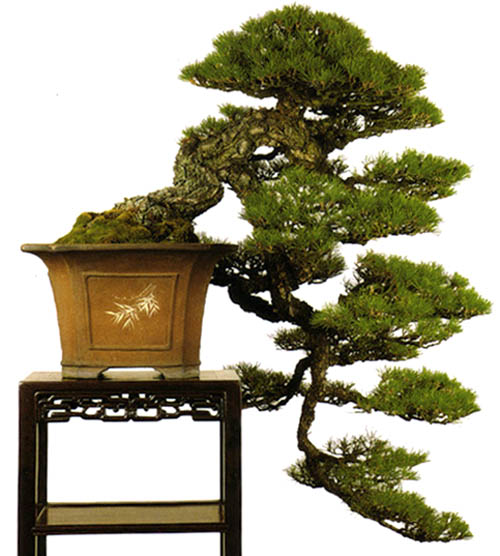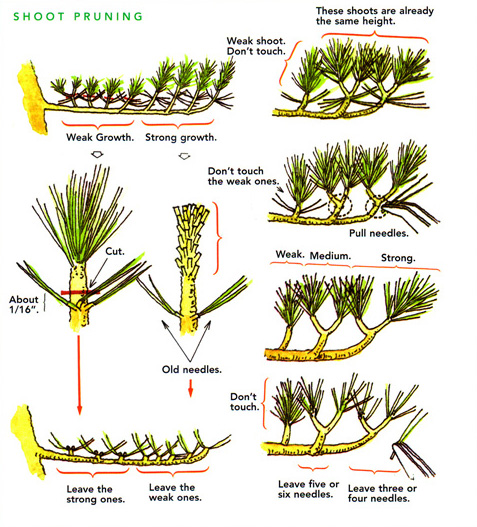
This powerful old cascading Japanese Black Pine (Pinus thunbergii) is a masterful example of how energy can be directed downward in a tree that naturally wants to grow upward. The photo is from Bonsai Today Master Series; Pines.
Whenever you prune, trim or pinch, you are redirecting energy.
If you remove a branch the energy (primarily water, gases and nutrients) that would have flown into that branch goes somewhere else. Some of it goes to forming a callous where the branch was, the rest goes elsewhere.
Basically energy flows two ways in plants; up from the roots, and back down from the leaves. For bonsai, it’s the up from the roots that we are primarily interested in.
Most plants are apically dominant. This means they put most of their energy from the roots up to their apex. This is particularly true of fast growing tall trees, like redwood, spruce etc. In these giants, survival of the fittest often means survival of the tallest.
Usually with bonsai, you want to move the energy down. Trimming and pinching the apex and allowing lower branches and twigs to grow unimpeded (at least for a while) is a good way to do this. For sure, there’s much more to energy balancing than just this, but it’s a start.
Some plants, like azaleas, are laterally, rather than apically, dominant. They naturally spread rather than grow primarily upward. These types of plants often make good bonsai, provided they have other desirable traits like short internodes and small leaves.
 These illustrations give an idea, of one part, of what goes into needle reduction and energy balancing on Japanese Black Pines. It’s from our Bonsai Today Master Series; Pines.
These illustrations give an idea, of one part, of what goes into needle reduction and energy balancing on Japanese Black Pines. It’s from our Bonsai Today Master Series; Pines.
Pines are particularly interesting when it comes to energy balancing. In addition to being apically dominant, most pines have fairly long internodes and longish needles. These present problems that any pine loving bonsai enthusiast needs to solve (unless the pines you love are already compact and have small needles).
Anyway, this post is just to whet your appetite and to get those of you who don’t think much about energy balancing to start thinking about it. Stay tuned for much more on the subject. We’ll be alternating between this topic and field growing and whatever else comes up.
Though this blog is entitled “Energy Balancing” I like to think of this as two separate features of one tree. The cascading pine that you selected for this blog really demonstrates the concepts of energy AND balance very well. I have found that the cascade bonsais that are most appealing to my eye are those that reflect a natural look rather than one that has been forced by styling. The idea of a of waterfalls cascading over rocks with pools on varous levels has always been my own inspirational way of evaluating a casdace style bonsai. If the tree reflects that kind of energy and balance (as does the pine above), then it is a successfully style tree. If not, then more work needs to be done.
I like the fact that your helping us. Thank you, I’m still learning here in MI. 4 yrs
Wayne Thanks for giving me a new look at controlling a trees energy in the way one side of a tree grows more than the other side or when I would like the first branch to grow bigger